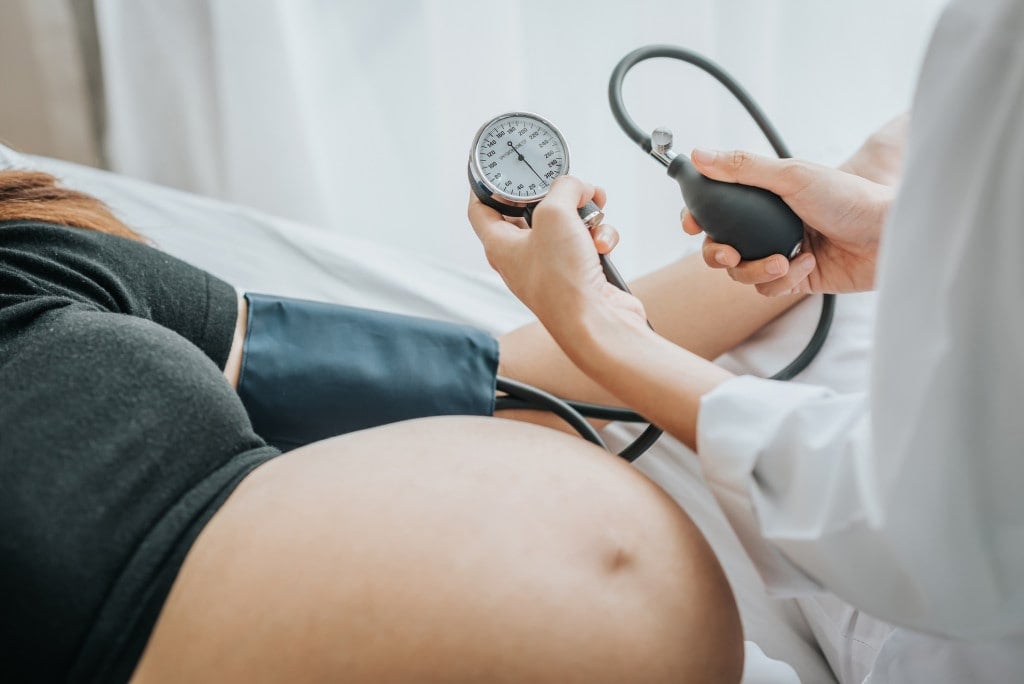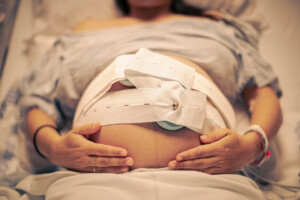Preeclampsia is a complication involving high blood pressure in pregnant women.1 It can occur as early as 20 weeks but usually in the third trimester, more commonly at the end of pregnancy (36+ weeks). Traces of protein found in the pregnant mother’s urine at a doctor or midwife’s checkup can be a sign of preeclampsia due to stressed maternal organs, likely the kidneys or liver. Regular prenatal checkups are one of the best ways to catch this pregnancy condition as early as possible to ensure the best treatment plan for both mother and baby.
There are natural solutions to help prevent preeclampsia in pregnant women, including lowering stress levels, eating healthy, and exercising. However, preeclampsia can be serious if not treated. Usually, the most effective treatment for severe preeclampsia is delivering the baby. However, if a mother isn’t close to her baby’s due date, she and her doctor can find solutions to ease the symptoms of preeclampsia while still allowing the baby to mature as fully as possible. In some cases, preeclampsia results in a baby being delivered early and having complications from premature birth. Severe preeclampsia can progress to “eclampsia,” which can be fatal for both mother and baby if left untreated.
Is preeclampsia common?
Preeclampsia is increasingly common in the United States, affecting about 1 in 25 pregnancies, rising by 25% over the last two decades with no clear reason as to why.2,3 Preeclampsia is responsible for up to 500,000 infant deaths and 76,000 maternal deaths worldwide. The US preeclampsia rate is 3-4 times higher than in other developed countries.
The condition affects 5-8 percent of pregnant women, but it tends to affect Hispanic and African American women more than women of Asian or European ancestry. In rare situations, preeclampsia develops after the delivery of a baby. This condition is known as postpartum preeclampsia.
Can preeclampsia be prevented?
There’s no way to prevent preeclampsia entirely, but there are many natural ways to reduce your chances of getting it. The number one way to prevent complications is to get regular prenatal healthcare so that your doctor or midwife can tell you if you are at risk.
Aside from regular doctor’s visits, prevention can start before you become pregnant. Consider making changes to your diet and exercise routines before or during pregnancy. Many of these tips overlap. For example, exercising helps reduce stress, which leads to better sleep at night.
Maintain a healthy weight.
Prioritize maintaining a healthy weight since women with higher BMI levels are more at risk for developing preeclampsia.
Drink water.
Drink at least 8-10 eight-ounce glasses of water per day.
Exercise.
Aim for at least 30 minutes of exercise per day, as long as your midwife or doctor approves.
Reduce stress.
Lowering the stress you feel will reduce your body’s inflammation and lower your blood pressure. Try methods for regular relaxation such as meditation, yoga, soothing baths, essential oils like lavender, prenatal massage, acupuncture, or walking in nature.
Sleep more.
Getting enough sleep is good for numerous reasons, including helping your body’s hormones to stay balanced and lowering blood pressure.
Take vitamin D.
Absorb sunshine by spending time outside (make sure not to get sunburned) or take vitamin D via food or supplements. One study showed that insufficient vitamin D in a mother’s diet is associated with preeclamptic women.4 You can supplement your diet with vitamin D-rich foods like cod liver oil, egg yolks, grass-fed butter, and sardines, or take a vitamin D supplement.
Take a prenatal vitamin.
Keep taking your prenatal vitamin regularly to ensure you cover all your bases for your mineral and vitamin intake.
Eat bananas.
Consume bananas or folic acid supplements regularly. A new study shows that folic acid can help reduce the risk of preeclampsia.5
Drink tart cherry juice.
Tart cherry juice contains high levels of naturally occurring melatonin. Melatonin is linked to better sleep, and a 2016 study found that not getting enough melatonin is linked to preeclampsia.6
Consume fiber-rich foods.
Fiber helps to lower blood pressure and even helps people with developed hypertension. Eat lots of fruit, vegetables, and grains for fiber.
Eat garlic.
Garlic helps lower blood pressure levels. You can eat garlic roasted or raw and add it to various meals. You can also take garlic in a supplement form found at your local grocer or pharmacy.
Consume beets.
Studies show that drinking beet juice quickly lowers blood pressure levels when consumed.7
Who is at risk?
- Pregnant women younger than 18 or 35 and older
- African American race
- Hispanic race
- Multifetal gestation (twins, triplets, etc.)
- Women from low socioeconomic status
- Women with a history of low birth weight babies
- Type 1 and Type 2 diabetes
- Obesity
- Chronic high blood pressure, kidney disease, or organ transplant
- First pregnancy or previous history of preeclampsia
- Women with 10 years or more between pregnancies
- Family history of preeclampsia, for example, your mother or sister had it
- Autoimmune disease, including lupus and multiple sclerosis
- Sickle cell disease
- In-vitro fertilization
What are the symptoms of preeclampsia?
- High blood pressure, usually after 20 weeks of pregnancy
- Decreased urine output
- Signs of organ difficulty, such as kidney or liver malfunction
- Traces of protein in the urine
- Severe headaches
- Nausea or vomiting
- Vision changes, including blurry vision (“floaters”) or light sensitivity
- Possible short-term vision loss
- Decreased platelet levels in the blood
- Shortness of breath caused by fluid in the lungs
- Upper abdominal pain, usually under your ribs on the right side
- Fluid retention
- Swelling of face and hands
- Rapid weight gain
What are the complications?
- Seizures
- Stroke
- Severe bleeding
- Separation of the placenta from the uterus
- Preterm delivery
Is preeclampsia deadly?
Preeclampsia is the beginning of a more serious condition called eclampsia, which can be deadly. Eclampsia is characterized by seizures, which is why preeclampsia treatment is vital.
What are the medical treatments?
If preeclampsia is mild and occurs after 37 weeks of pregnancy, treatment may include the following:
- Delivering the baby
- Regular blood pressure and urine tests to monitor the progression of the condition
- Magnesium sulfate treatments for the mother to prevent seizures
In more severe cases that occur earlier in the pregnancy, treatment might include the following:
- Admitting the pregnant mother to the hospital for close monitoring
- Medications for the baby’s lung development, to manage the mother’s blood pressure, and to prevent seizures
- Delivering a baby at 34 weeks or preterm for safety reasons
Are there natural remedies?
Natural remedies for lowering your chances of high blood pressure associated with preeclampsia and getting good, thorough prenatal care are the best preventatives for this condition. Having regular visits to an obstetrician or healthcare provider is important because it ensures that mom is often checked for changes in her blood pressure, possible protein in the urine, or any other symptoms of preeclampsia.
If preeclampsia is found early, close monitoring by an obstetrician can help the mother and baby stay healthy. If you think you may have preeclampsia, contact your healthcare provider for a checkup as soon as possible. Sometimes typical signs of pregnancy, such as water retention and weight gain, can be confused with symptoms of preeclampsia. A medical professional can determine if you are at risk or not.
For women with risk factors, taking aspirin every day starting early in pregnancy can help prevent the development of preeclampsia, but only done so at the instruction of a mother’s healthcare provider.














